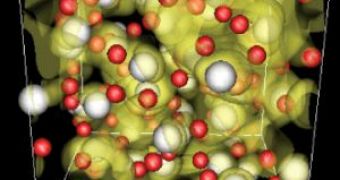A team of theoretical physicists from Sandia National Lab argues that a form of electrically conductive water might exist inside the gas giant planets. The extreme conditions on these planets could lead to a phase transition from the non-conductive water to the conductive form.
A phase transition is an abrupt transformation of one or many physical characteristics of a substance while there is a small change in other properties (such as temperature or pressure). The most common phase transitions of water are the transition from ice to liquid and from liquid to vapors.
Thomas Mattsson and his colleagues have determined that water should change into the "metallic" form at a temperature of 4000 K and a pressure of 100 gigapascals. Such a pressure is equivalent to the pressure that would be exerted on Earth by a column of water one trillion kilometers in height. Believe it or not, this estimate is more moderate than the previous ones.
Nonetheless, physicists think that such conditions exit on planets like Jupiter or Neptune. Although they are far from the Sun and thus receive little sunlight, especially Neptune, they are very hot deep inside their atmospheres. And due to their huge size, Jupiter for instance is 2.5 times more massive than all the other planets combined; the pressure deep inside their atmospheres reaches huge figures.
Because of the high pressure, this form of water is thought to be solid - it is a form of electrically conductive ice. This form of ice is close to another form of exotic ice called "superionic" ice. The "superionic" ice is an electric insulator but its hydrogen atoms are free to move around while the oxygens are frozen in place.
The image shows a simulation of metallic ice, revealing the disordered structure. Red spheres are hydrogen atoms while white spheres are oxygen atoms. The electron density from a partially occupied electron state, responsible for the conductivity, is shown as gold. Credit: Mattsson and Desjarlais.
Researchers plan to study this form of water with the help of the Sandia's Z Machine. The Z Machine is capable of producing huge energy bursts using X rays and can thus produce a short-lived high-temperature, high-pressure fluid environment. The Z Machine has produced the highest temperature ever recorder and scientists are still baffled by how it did it.

 14 DAY TRIAL //
14 DAY TRIAL //